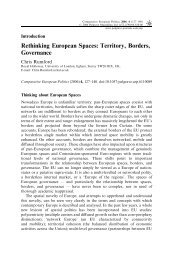Europeanisation, National Identities and Migration ... - europeanization
Europeanisation, National Identities and Migration ... - europeanization
Europeanisation, National Identities and Migration ... - europeanization
You also want an ePaper? Increase the reach of your titles
YUMPU automatically turns print PDFs into web optimized ePapers that Google loves.
106 Krystyna Romaniszyn<br />
the status of women either within the household or in society at large (Bilsborrow<br />
<strong>and</strong> Zlotnik 1992: 140). This, however, is true only in the case of immigrants who<br />
have settled in a host country. Those migrant women who just work abroad<br />
providing their families with remittances, <strong>and</strong> take over the role of family breadwinners,<br />
by this very fact improve their status within the household back in the<br />
home country regardless of their job. Employed as domestic servants, migrant<br />
women also help the professional career of their female employers by undertaking<br />
the domestic duties of the latter. Indeed, the career of the middle-class women<br />
in the host societies has been augmented by the employment of foreign women<br />
servants undertaking their patrons’ housewife duties. Thus, in the long run, female<br />
migration affects gender relations within migrant families by improving these<br />
women’s status, <strong>and</strong> within the recipient families by easing the professional careers<br />
of wives <strong>and</strong> mothers.<br />
Third, migration may well reshape, or develop new patterns of accepted<br />
behaviour. For example, the widespread approval of migration in the sending<br />
country or just in its out-migration regions – when it occurs – reveals the development<br />
of a new social norm of proper behaviour in these regions. According to<br />
this norm, migration is collectively perceived as a sound <strong>and</strong> workable life strategy.<br />
In turn, the social acceptance of a migratory life further accelerates migration,<br />
which may even be treated as a rite of passage – one means by which people<br />
make their transition into adulthood <strong>and</strong> social prestige depicted, for instance,<br />
in numerous local communities in the west of Irel<strong>and</strong> (Gmelch 1987: 266ff.). The<br />
emerging <strong>and</strong> functioning of this norm builds the local culture of migration.<br />
A rise in the social status of the migrant households, basically due to remittances<br />
<strong>and</strong> enhanced consumption ability, is one indicator of this culture.<br />
Fourth, international inflows leading to concentration <strong>and</strong> settlement of the<br />
newcomers from numerous countries in particular districts or residential areas<br />
result in a qualitative change of the ‘affected’ local communities. The reason for this<br />
is that the new residents originating from various nations have their meaningful<br />
social relations not with the immediate neighbours, as used to happen, but entirely<br />
outside the local community <strong>and</strong> across the globe (Albrow 1997: 53). The effect<br />
of this novel pattern of behaviour <strong>and</strong> settlement is twofold: first, the newcomers do<br />
not assimilate into the local community <strong>and</strong> its culture; second, their ‘semi-presence’<br />
changes the local community so that it gradually loses its specific culture. In<br />
such instances, locality parts with community. This crucial change obviously does<br />
not pertain to all local communities inhabited by immigrants nor to all local<br />
communities in the target countries, which means a diversification also in this social<br />
sphere.<br />
The influence of international migration is to be traced also in the sphere of<br />
symbolic culture, in the spread of new values, norms <strong>and</strong> ideas, including religious<br />
norms <strong>and</strong> values. Again, migration is not the only or the chief source of the dissemination<br />
of new ideas in contemporary societies: the mass media communicates<br />
<strong>and</strong> spreads them on a global scale. Nevertheless, migrants themselves <strong>and</strong> their<br />
communities may effectively import new ideas, norms <strong>and</strong> values, or help to revive<br />
old <strong>and</strong> muted ones in the host society. The former instance may be observed in



